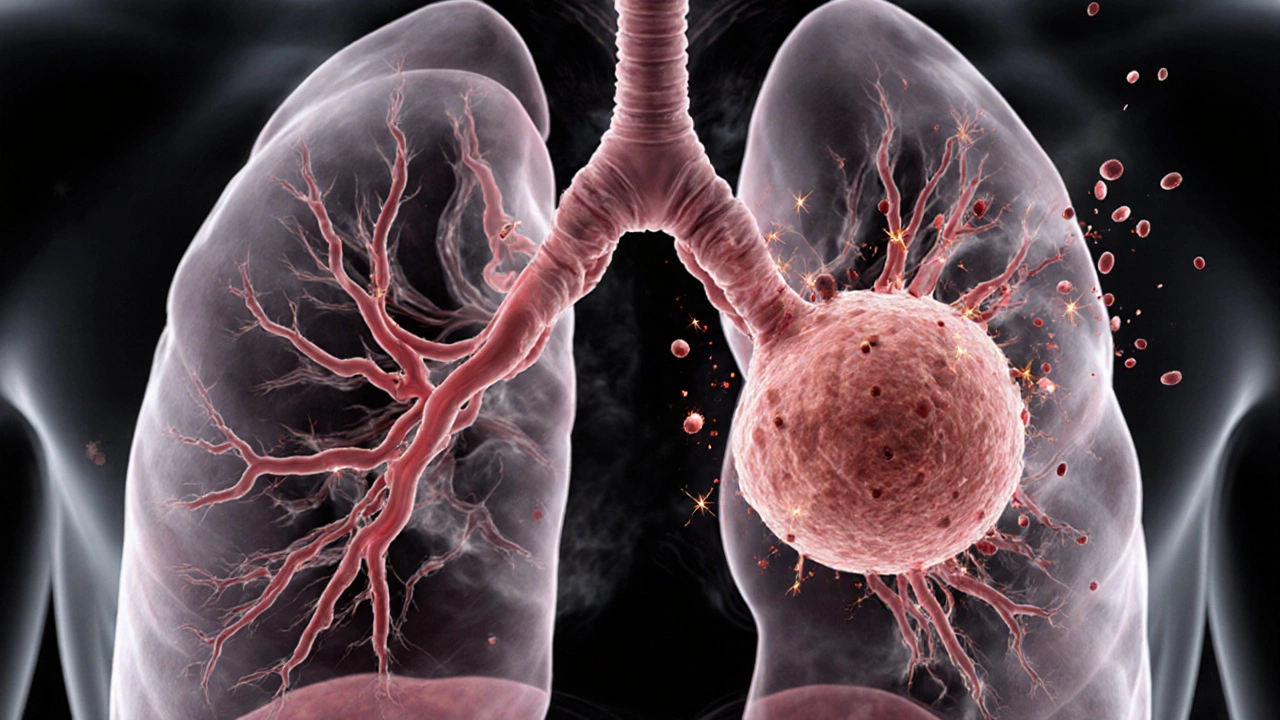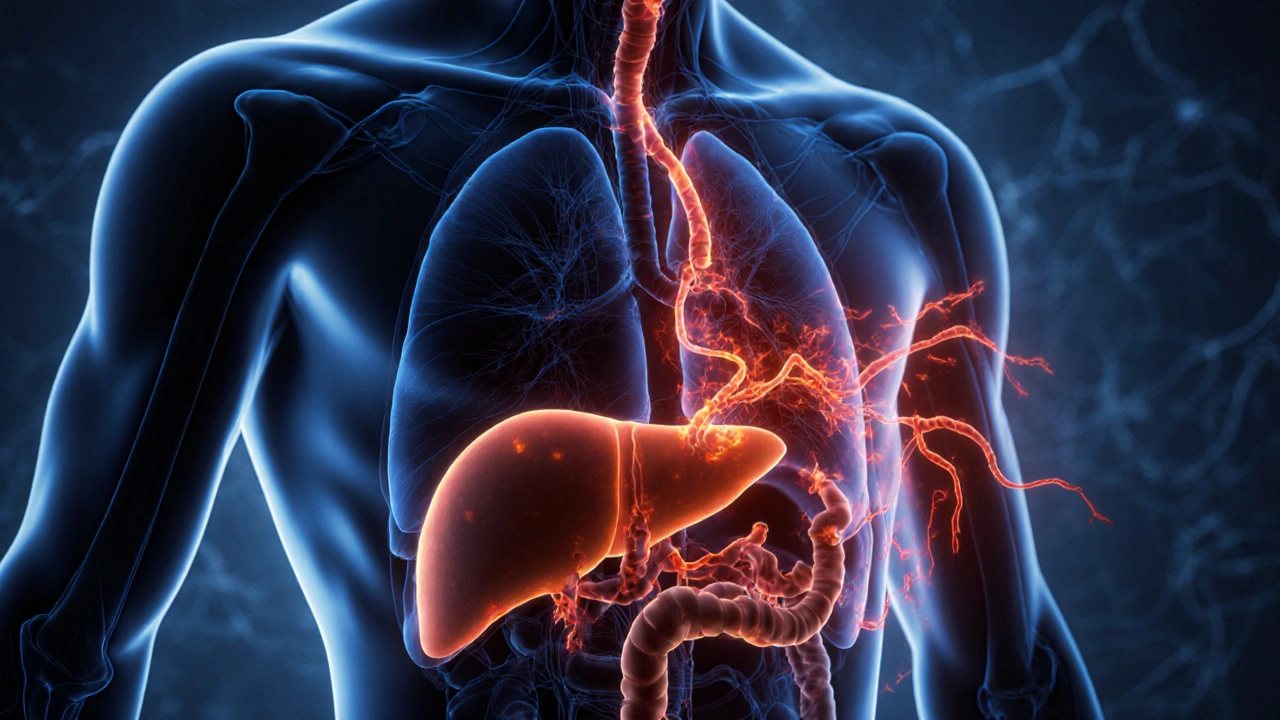Cancer Survival Rate Estimator
Estimate the 5-year survival rate for common fast-spreading cancers based on stage at diagnosis. This tool uses data from the American Cancer Society and major cancer research studies. Important: Survival rates are statistical averages and individual outcomes may vary significantly.
Estimated 5-Year Survival
Based on current medical data
Important Note:
This is a statistical estimate only. Individual outcomes depend on many factors including age, overall health, treatment options, and response to therapy. Always consult with a medical professional for personalized information.
When someone hears the word cancer, the first thing that comes to mind isn’t just the disease-it’s how fast it might spread. Not all cancers are the same. Some grow slowly for years without causing trouble. Others move like wildfire, turning a localized tumor into a full-body crisis in months. So which cancer spreads the fastest? The answer isn’t simple, but the evidence points clearly to a few aggressive types that demand urgent attention.
Pancreatic Cancer: The Silent Speedster
Pancreatic cancer is often called the silent killer for a reason. By the time symptoms show up-jaundice, unexplained weight loss, stomach pain-the cancer has usually already spread. The pancreas sits deep in the abdomen, surrounded by major blood vessels and lymph nodes. This location makes it easy for cancer cells to escape early and travel to the liver, lungs, or peritoneum.
Studies from the American Cancer Society show that over 80% of pancreatic cancers are diagnosed at stage III or IV, meaning they’ve already metastasized. The median survival for stage IV pancreatic cancer is just 3 to 6 months without treatment. Even with chemotherapy, fewer than 3% of patients survive five years. Its speed isn’t just about cell division-it’s about how early and how far it moves before anyone notices.
Liver Cancer: Fast Growth, Fast Spread
Liver cancer, especially hepatocellular carcinoma (HCC), is another aggressive player. It often develops in people with chronic liver disease-like hepatitis B or C, or long-term alcohol abuse. The liver’s rich blood supply acts like a highway for cancer cells. Once a tumor forms, it can quickly invade nearby blood vessels and spread to the lungs, bones, or lymph nodes.
Research from the Journal of Hepatology shows that liver cancer can double in size in as little as 30 days in some cases. It doesn’t wait for symptoms to appear. By the time patients feel pain or notice swelling, the cancer has often moved beyond the liver. Survival rates drop sharply after metastasis: the five-year survival rate for localized liver cancer is around 31%, but once it spreads, it falls to just 3%.
Lung Cancer: The Most Common Fast Mover
Lung cancer is the leading cause of cancer death worldwide-and for good reason. Small cell lung cancer (SCLC), in particular, is one of the fastest-spreading cancers known. It grows rapidly and often spreads to the brain, bones, liver, and adrenal glands before diagnosis. Up to 70% of SCLC cases are already metastatic when first detected.
Non-small cell lung cancer (NSCLC) spreads slower, but still faster than many other cancers. The key issue? Lung cancer rarely causes pain early on. People mistake coughing or shortness of breath for a cold or bronchitis. By the time a scan is done, cancer cells have already traveled through the bloodstream or lymphatic system. The five-year survival rate for metastatic lung cancer is under 8%.

Triple-Negative Breast Cancer: Aggressive Even Among Breast Cancers
Not all breast cancers are slow-growing. Triple-negative breast cancer (TNBC) lacks estrogen, progesterone, and HER2 receptors-meaning hormone therapies and targeted drugs don’t work. This leaves chemotherapy as the main option, and even then, the cancer often returns quickly.
TNBC spreads more often to the lungs, brain, and liver than other breast cancer types. It’s more common in younger women and Black women. Studies show TNBC has a higher rate of distant recurrence within the first three years after diagnosis compared to other subtypes. While it’s not as fast as pancreatic or lung cancer overall, its aggressive behavior makes it one of the most dangerous forms of breast cancer.
Other Fast-Spreading Cancers to Know
Some other cancers also move quickly under the right conditions:
- Melanoma (skin cancer): When it becomes invasive, melanoma can spread to lymph nodes and organs in months. Early detection saves lives.
- Cholangiocarcinoma (bile duct cancer): Rare but deadly, it spreads early along bile ducts and into the liver.
- Esophageal cancer: Grows rapidly and often spreads to nearby lymph nodes and the liver before symptoms appear.
What these cancers have in common? They don’t cause obvious symptoms until they’ve already moved. That’s why early screening matters-even if you feel fine.

Why Do Some Cancers Spread So Fast?
It’s not just about how fast the cells divide. It’s about how well they escape the original site, survive in the bloodstream, and settle in new organs. Fast-spreading cancers usually have:
- High genetic mutations that make them more adaptable
- Strong ability to trigger angiogenesis (grow new blood vessels to feed themselves)
- Willingness to invade blood and lymph vessels early
- Resistance to the immune system’s attempts to kill them
Pancreatic cancer, for example, creates a thick protective shield around tumors called the stroma. This shield blocks chemotherapy and hides cancer cells from immune cells. Lung cancer cells often carry mutations in genes like EGFR or KRAS that make them highly mobile. These biological traits are what make them so dangerous.
What Can You Do?
You can’t prevent every cancer, but you can reduce your risk and catch fast-spreading types early:
- Don’t smoke. Smoking is the #1 risk factor for lung and pancreatic cancer.
- Limit alcohol. Heavy drinking increases liver and esophageal cancer risk.
- Get screened if you’re high-risk. People with chronic hepatitis, pancreatitis, or strong family history should talk to their doctor about imaging tests.
- Know your body. Unexplained weight loss, persistent pain, or new lumps shouldn’t be ignored.
- Consider genetic testing if you have a family history of early-onset cancers.
Early detection isn’t just about survival-it’s about treatment options. A localized tumor can often be removed. Once cancer spreads, treatment becomes about managing the disease, not curing it.
Myth: Fast-Spreading Cancers Are Always Fatal
It’s true that these cancers have low survival rates. But that doesn’t mean all hope is lost. New treatments are emerging every year. Immunotherapy, targeted drugs, and precision medicine are helping some patients live longer than ever before.
For example, some patients with metastatic melanoma now live over five years thanks to checkpoint inhibitors. A small group of pancreatic cancer patients with specific genetic mutations respond well to newer chemotherapy combinations. Even in advanced cases, treatment can improve quality of life and extend survival by months or even years.
The goal isn’t just to survive-it’s to live well. That’s why early detection, personalized care, and staying informed matter more than ever.
Is pancreatic cancer the fastest-spreading cancer?
Yes, pancreatic cancer is among the fastest-spreading cancers, especially because it often spreads before symptoms appear. Over 80% of cases are diagnosed after the cancer has already moved to other organs. Its location near major blood vessels and its ability to hide from the immune system make it particularly aggressive.
Can fast-spreading cancers be caught early?
It’s difficult, but possible. Some cancers like lung and pancreatic have no routine screening for the general public. However, people with high risk-such as smokers, those with chronic liver disease, or a family history-should discuss imaging tests like low-dose CT scans or endoscopic ultrasounds with their doctor. Paying attention to unexplained symptoms like weight loss, jaundice, or persistent cough can lead to earlier diagnosis.
Does cancer spread faster in younger people?
Not necessarily. Age doesn’t directly make cancer spread faster. But younger people are more likely to develop aggressive subtypes, like triple-negative breast cancer or certain types of melanoma. Also, younger patients may ignore symptoms, thinking they’re too young to have cancer, which delays diagnosis and gives the cancer more time to spread.
What are the signs that cancer has spread?
Symptoms depend on where the cancer spreads. Common signs include: unexplained bone pain (spread to bones), headaches or seizures (spread to brain), shortness of breath (spread to lungs), yellow skin or dark urine (spread to liver), and swelling in the abdomen (spread to peritoneum). Sudden weight loss, extreme fatigue, and loss of appetite are also red flags.
Can lifestyle changes slow down cancer spread?
Lifestyle changes alone won’t stop cancer from spreading once it’s advanced. But they can improve treatment outcomes and overall health. Quitting smoking, eating a balanced diet, staying active, and managing stress help the body respond better to treatment and reduce inflammation, which can fuel cancer growth. For people in remission, healthy habits lower the risk of recurrence.





